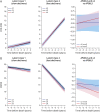Neuropathology-Independent Association Between APOE Genotype and Cognitive Decline Rate in the Normal Aging-Early Alzheimer Continuum
- PMID: 36698453
- PMCID: PMC9869750
- DOI: 10.1212/NXG.0000000000200055
Neuropathology-Independent Association Between APOE Genotype and Cognitive Decline Rate in the Normal Aging-Early Alzheimer Continuum
Abstract
Background and objectives: We previously found that the APOE genotype affects the rate of cognitive decline in mild-to-moderate Alzheimer disease (AD) dementia independently of its effects on AD neuropathologic changes (ADNC) and copathologies. In this study, we tested the hypothesis that the APOE alleles differentially affect the rate of cognitive decline at the normal aging-early AD continuum and that this association is independent of their effects on classical ADNC and copathologies.
Methods: We analyzed APOE associations with the cognitive trajectories (Clinical Dementia Rating scale Sum of Boxes [CDR-SOB] and Mini-Mental State Examination [MMSE]) of more than 1,000 individuals from a national clinicopathologic sample who had either no, mild (sparse neuritic plaques and the Braak neurofibrillary tangle [NFT] stage I/II), or intermediate (moderate neuritic plaques and the Braak NFT stage III/IV) ADNC levels at autopsy via 2 latent classes reverse-time longitudinal modeling.
Results: Carrying the APOEε4 allele was associated with a faster rate of cognitive decline by both CDR-SOB and MMSE relative to APOEε3 homozygotes. This association remained statistically significant after adjusting for ADNC severity, comorbid pathologies, and the effects of ADNC on the slope of cognitive decline. Our modeling strategy identified 2 latent classes in which APOEε4 carriers declined faster than APOEε3 homozygotes, with latent class 1 members representing slow decliners (CDR-SOB: 76.7% of individuals, 0.195 vs 0.146 points/y in APOEε4 vs APOEε3/ε3; MMSE: 88.6% of individuals, -0.303 vs -0.153 points/y in APOEε4 vs APOEε3/ε3), whereas latent class 2 members were fast decliners (CDR-SOB: 23.3% of participants, 1.536 vs 1.487 points/y in APOEε4 vs APOEε3/ε3; MMSE: 11.4% of participants, -2.538 vs -2.387 points/y in APOEε4 vs APOEε3/ε3). Compared with slow decliners, fast decliners were more likely to carry the APOEε4 allele, younger at initial visit and death, more impaired at initial and last visits, and more likely to have intermediate (vs none or mild) ADNC levels, as well as concurrent Lewy bodies and hippocampal sclerosis at autopsy.
Discussion: In a large national sample selected to represent the normal aging-early AD continuum, the APOEε4 allele is associated with a modest but statistically significant acceleration of the cognitive decline rate even after controlling for its effects on ADNC and comorbid pathologies.
Copyright © 2023 The Author(s). Published by Wolters Kluwer Health, Inc. on behalf of the American Academy of Neurology.
Figures



Similar articles
-
Association of APOE Genotype With Heterogeneity of Cognitive Decline Rate in Alzheimer Disease.Neurology. 2021 May 11;96(19):e2414-e2428. doi: 10.1212/WNL.0000000000011883. Epub 2021 Mar 26. Neurology. 2021. PMID: 33771840 Free PMC article.
-
APOEε2 is associated with milder clinical and pathological Alzheimer disease.Ann Neurol. 2015 Jun;77(6):917-29. doi: 10.1002/ana.24369. Ann Neurol. 2015. PMID: 25623662 Free PMC article.
-
Cognitive decline profiles associated with lewy pathology in the context of Alzheimer's disease neuropathologic change.Alzheimers Res Ther. 2024 Dec 20;16(1):270. doi: 10.1186/s13195-024-01628-z. Alzheimers Res Ther. 2024. PMID: 39707423 Free PMC article.
-
Association between APOE-ε4 allele and cognitive function is mediated by Alzheimer's disease pathology: a population-based autopsy study in an admixed sample.Acta Neuropathol Commun. 2023 Dec 19;11(1):205. doi: 10.1186/s40478-023-01681-z. Acta Neuropathol Commun. 2023. PMID: 38115150 Free PMC article. Review.
-
Association of apolipoprotein E genetic variation in Alzheimer's disease in Indian population: a meta-analysis.Am J Alzheimers Dis Other Demen. 2014 Nov;29(7):575-82. doi: 10.1177/1533317514531443. Am J Alzheimers Dis Other Demen. 2014. PMID: 25551132 Free PMC article. Review.
Cited by
-
Multifaceted roles of APOE in Alzheimer disease.Nat Rev Neurol. 2024 Aug;20(8):457-474. doi: 10.1038/s41582-024-00988-2. Epub 2024 Jun 21. Nat Rev Neurol. 2024. PMID: 38906999 Free PMC article. Review.
-
APOE genotype and sex modulate Alzheimer's disease pathology in aged EFAD transgenic mice.Front Aging Neurosci. 2023 Oct 31;15:1279343. doi: 10.3389/fnagi.2023.1279343. eCollection 2023. Front Aging Neurosci. 2023. PMID: 38020764 Free PMC article.
-
Parkinson Disease Neuropathological Comorbidities: Prevalences from Younger-Old to Older-Old, With Comparison to Non-Demented, Non-Parkinsonian Subjects.medRxiv [Preprint]. 2025 Jan 15:2025.01.13.25319971. doi: 10.1101/2025.01.13.25319971. medRxiv. 2025. PMID: 39867383 Free PMC article. Preprint.
-
Fast Declining Prediction in Alzheimer's Disease from Early Clinical Assessment.Curr Neuropharmacol. 2025;23(5):602-611. doi: 10.2174/011570159X332930240925095423. Curr Neuropharmacol. 2025. PMID: 39473253 Free PMC article.
-
Phishing vulnerability compounded by older age, apolipoprotein E e4 genotype, and lower cognition.PNAS Nexus. 2024 Aug 1;3(8):pgae296. doi: 10.1093/pnasnexus/pgae296. eCollection 2024 Aug. PNAS Nexus. 2024. PMID: 39118834 Free PMC article.
References
Grants and funding
- P20 AG068053/AG/NIA NIH HHS/United States
- P30 AG066515/AG/NIA NIH HHS/United States
- P30 AG062421/AG/NIA NIH HHS/United States
- P30 AG066508/AG/NIA NIH HHS/United States
- P30 AG066519/AG/NIA NIH HHS/United States
- P30 AG072973/AG/NIA NIH HHS/United States
- P30 AG066462/AG/NIA NIH HHS/United States
- P30 AG066530/AG/NIA NIH HHS/United States
- P30 AG066509/AG/NIA NIH HHS/United States
- P20 AG068077/AG/NIA NIH HHS/United States
- P30 AG066546/AG/NIA NIH HHS/United States
- P30 AG072972/AG/NIA NIH HHS/United States
- P30 AG072979/AG/NIA NIH HHS/United States
- K08 AG064039/AG/NIA NIH HHS/United States
- P20 AG068082/AG/NIA NIH HHS/United States
- P30 AG072975/AG/NIA NIH HHS/United States
- P30 AG066444/AG/NIA NIH HHS/United States
- P30 AG066507/AG/NIA NIH HHS/United States
- P30 AG072946/AG/NIA NIH HHS/United States
- P30 AG066518/AG/NIA NIH HHS/United States
- P30 AG066511/AG/NIA NIH HHS/United States
- U24 AG072122/AG/NIA NIH HHS/United States
- P30 AG066512/AG/NIA NIH HHS/United States
- P30 AG072978/AG/NIA NIH HHS/United States
- P30 AG062429/AG/NIA NIH HHS/United States
- P30 AG062422/AG/NIA NIH HHS/United States
- R01 AG079280/AG/NIA NIH HHS/United States
- P30 AG072977/AG/NIA NIH HHS/United States
- P30 AG062677/AG/NIA NIH HHS/United States
- P20 AG068024/AG/NIA NIH HHS/United States
- P30 AG072958/AG/NIA NIH HHS/United States
- P30 AG062715/AG/NIA NIH HHS/United States
- P30 AG066506/AG/NIA NIH HHS/United States
- P30 AG066468/AG/NIA NIH HHS/United States
- P30 AG072976/AG/NIA NIH HHS/United States
- P30 AG072947/AG/NIA NIH HHS/United States
- P30 AG072931/AG/NIA NIH HHS/United States
- P30 AG066514/AG/NIA NIH HHS/United States
- P30 AG072959/AG/NIA NIH HHS/United States
LinkOut - more resources
Full Text Sources
Miscellaneous
